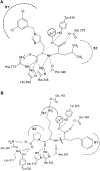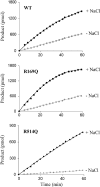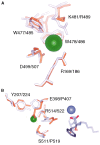Identification of critical active-site residues in angiotensin-converting enzyme-2 (ACE2) by site-directed mutagenesis
- PMID: 16008552
- PMCID: PMC7164114
- DOI: 10.1111/j.1742-4658.2005.04756.x
Identification of critical active-site residues in angiotensin-converting enzyme-2 (ACE2) by site-directed mutagenesis
Abstract
Angiotensin-converting enzyme-2 (ACE2) may play an important role in cardiorenal disease and it has also been implicated as a cellular receptor for the severe acute respiratory syndrome (SARS) virus. The ACE2 active-site model and its crystal structure, which was solved recently, highlighted key differences between ACE2 and its counterpart angiotensin-converting enzyme (ACE), which are responsible for their differing substrate and inhibitor sensitivities. In this study the role of ACE2 active-site residues was explored by site-directed mutagenesis. Arg273 was found to be critical for substrate binding such that its replacement causes enzyme activity to be abolished. Although both His505 and His345 are involved in catalysis, it is His345 and not His505 that acts as the hydrogen bond donor/acceptor in the formation of the tetrahedral peptide intermediate. The difference in chloride sensitivity between ACE2 and ACE was investigated, and the absence of a second chloride-binding site (CL2) in ACE2 confirmed. Thus ACE2 has only one chloride-binding site (CL1) whereas ACE has two sites. This is the first study to address the differences that exist between ACE2 and ACE at the molecular level. The results can be applied to future studies aimed at unravelling the role of ACE2, relative to ACE, in vivo.
Figures






Similar articles
-
Residues affecting the chloride regulation and substrate selectivity of the angiotensin-converting enzymes (ACE and ACE2) identified by site-directed mutagenesis.FEBS J. 2008 Dec;275(23):6033-42. doi: 10.1111/j.1742-4658.2008.06733.x. FEBS J. 2008. PMID: 19021774 Free PMC article.
-
Angiotensin-converting enzyme-2 (ACE2): comparative modeling of the active site, specificity requirements, and chloride dependence.Biochemistry. 2003 Nov 18;42(45):13185-92. doi: 10.1021/bi035268s. Biochemistry. 2003. PMID: 14609329
-
ACE2 X-ray structures reveal a large hinge-bending motion important for inhibitor binding and catalysis.J Biol Chem. 2004 Apr 23;279(17):17996-8007. doi: 10.1074/jbc.M311191200. Epub 2004 Jan 30. J Biol Chem. 2004. PMID: 14754895 Free PMC article.
-
Angiotensin-converting enzyme-2: a molecular and cellular perspective.Cell Mol Life Sci. 2004 Nov;61(21):2704-13. doi: 10.1007/s00018-004-4240-7. Cell Mol Life Sci. 2004. PMID: 15549171 Free PMC article. Review.
-
Membrane-associated zinc peptidase families: comparing ACE and ACE2.Biochim Biophys Acta. 2005 Aug 1;1751(1):2-8. doi: 10.1016/j.bbapap.2004.10.010. Epub 2004 Nov 6. Biochim Biophys Acta. 2005. PMID: 16054014 Free PMC article. Review.
Cited by
-
Reply to Liu et al.: Specific mutations matter in specificity and catalysis in ACE2.Proc Natl Acad Sci U S A. 2021 Apr 13;118(15):e2024450118. doi: 10.1073/pnas.2024450118. Proc Natl Acad Sci U S A. 2021. PMID: 33833059 Free PMC article. No abstract available.
-
Honghua extract mediated potent inhibition of COVID-19 host cell pathways.Sci Rep. 2022 Aug 22;12(1):14296. doi: 10.1038/s41598-022-15338-9. Sci Rep. 2022. PMID: 35995784 Free PMC article.
-
An ACE2 Microbody Containing a Single Immunoglobulin Fc Domain Is a Potent Inhibitor of SARS-CoV-2.Cell Rep. 2020 Dec 22;33(12):108528. doi: 10.1016/j.celrep.2020.108528. Epub 2020 Dec 1. Cell Rep. 2020. PMID: 33326798 Free PMC article.
-
In silico identification of compounds from Nigella sativa seed oil as potential inhibitors of SARS-CoV-2 targets.Bull Natl Res Cent. 2021;45(1):57. doi: 10.1186/s42269-021-00517-x. Epub 2021 Mar 12. Bull Natl Res Cent. 2021. PMID: 33727782 Free PMC article.
-
Potent Antiviral Activity of Vitamin B12 against Severe Acute Respiratory Syndrome Coronavirus 2, Middle East Respiratory Syndrome Coronavirus, and Human Coronavirus 229E.Microorganisms. 2023 Nov 15;11(11):2777. doi: 10.3390/microorganisms11112777. Microorganisms. 2023. PMID: 38004788 Free PMC article.
References
-
- Tipnis SR, Hooper NM, Hyde R, Karran E, Christie G & Turner AJ (2000) A human homolog of angiotensin‐converting enzyme: cloning and functional expression as a captopril‐insensitive carboxypeptidase. J Biol Chem 275, 33238–33243. - PubMed
-
- Donoghue M, Hsieh F, Baronas E, Godbout K, Gosselin M, Stagliano N, Donovan M, Woolf B, Robison K, Jeyaseelan R et al. (2000) A novel angiotensin‐converting enzyme‐related carboxypeptidase (ACE2) converts angiotensin I to angiotensin 1–9. Circ Res 87, E1–E9. - PubMed
-
- Vickers C, Hales P, Kaushik V, Dick L, Gavin J, Tang J, Godbout K, Parsons T, Baronas E, Hsieh F et al. (2002) Hydrolysis of biological peptides by human angiotensin‐converting enzyme‐related carboxypeptidase. J Biol Chem 277, 14838–14843. - PubMed
-
- Crackower MA, Sarao R, Oudit GY, Yagil C, Kozieradzki I, Scanga SE, Oliveira‐dos‐Santos AJ, da Costa J, Zhang L, Pei Y et al. (2002) Angiotensin‐converting enzyme 2 is an essential regulator of heart function. Nature 417, 822–828. - PubMed
Publication types
MeSH terms
Substances
LinkOut - more resources
Full Text Sources
Other Literature Sources
Molecular Biology Databases
Miscellaneous

